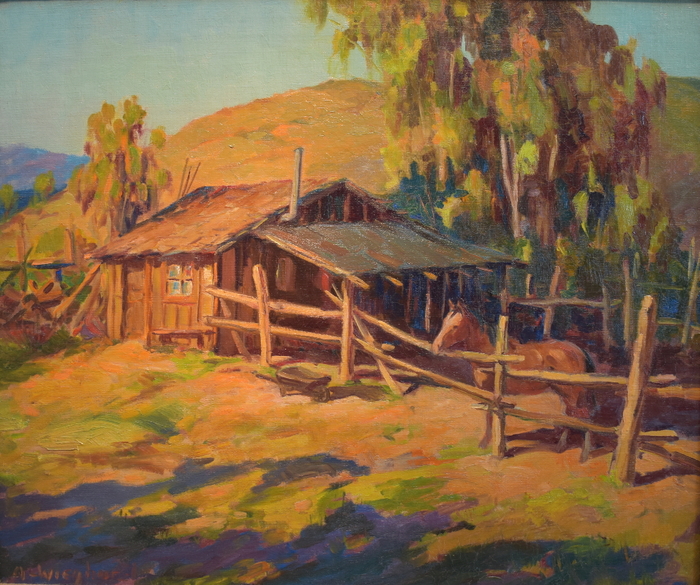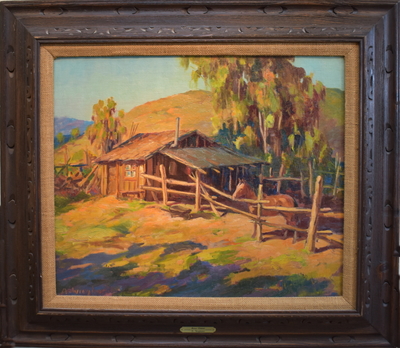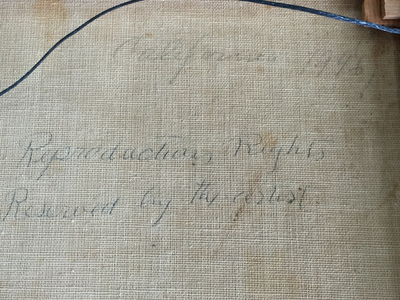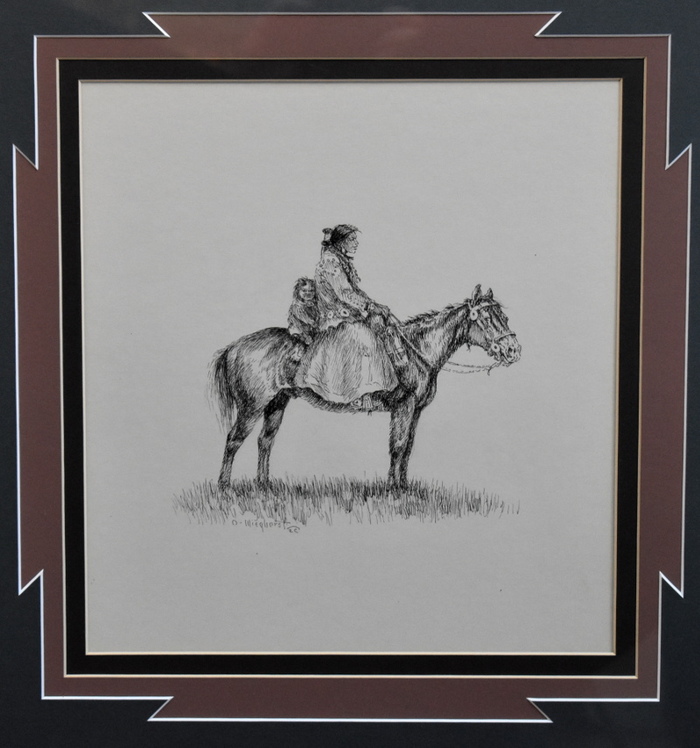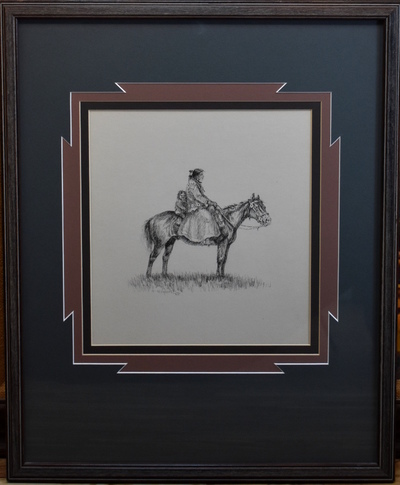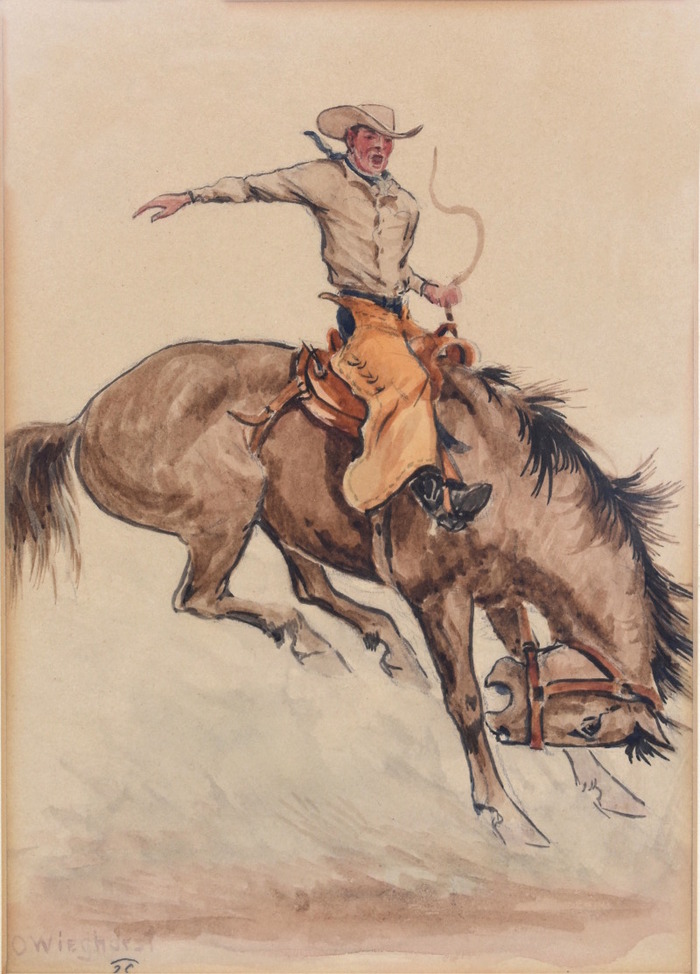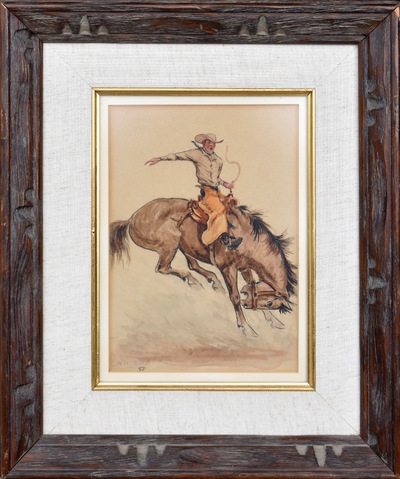-
Olaf Wieghorst (1899 - 1988)
-
Paintings
-
- Olaf Wieghorst
- (1899 - 1988)
- California, New York, New Mexico, Arizona, Texas Artist
- Size: 11 x 8.5
- Frame: 18.5 x 14.5
- Medium: Print
- "Indian on Horse"
- View details
- Contact for Price & Info
-
- Olaf Wieghorst
- (1899 - 1988)
- California, New York, New Mexico, Arizona, Texas Artist
- Size: 20 x 24
- Frame: 29.5 x 33
- Medium: oil
- 1946
- "Home Corral" California
- View details
- Contact for Price & Info
-
- Olaf Wieghorst
- (1899 - 1988)
- California, New York, New Mexico, Arizona, Texas Artist
- Size: 12 x 13
- Frame: 26.5 x 21.5
- Medium: Ink Drawing
- "Mother & Child"
- View details
- Contact for Price & Info
-
- Olaf Wieghorst
- (1899 - 1988)
- California, New York, New Mexico, Arizona, Texas Artist
- Size: 10 x 8
- Frame: 17 x 14
- Medium: Watercolor
- "Bucking Bronco"
- View details
- Contact for Price & Info
-
-
Biography
Olaf Wieghorst (1899 - 1988) California, New York, New Mexico, Arizona, Texas Artist
Born in Viborg, Denmark, Olaf Wieghorst was a child acrobatic performer from the age of nine when he began appearances at Tivoli Theater in Copenhagen and later toured Europe. He also learned horseback riding working on a stock farm, and horses became a major focus of his admiration and later his painting.
In 1918, he arrived in the United States, having worked as a cabin boy on a steamer. He served in the 5th U.S. Cavalry on the Mexican border in the days of Pancho Villa. He later recalled a favorite horse from that period and said that riding through El Paso in 1921, the horse fell on his ankle and broke it. The outfit was heading to Douglas, Arizona, and not wanting to be left behind with his injury, he stayed on the horse which carried him all the way through the New Mexico desert on one of the hottest days of the year. The horse died during the night, having expended all his energy on saving Wieghorst. He later wrote that when the Cavalry discarded the use of horses, "they took the soul out of that great branch of the service" ("Widening Horizons").
He wandered extensively through the West sometimes on horseback, finding work in Arizona and New Mexico as a cowboy. Then he went to New York and served as a mounted policeman until 1944, spending most of his time on a horse named Rhombo patrolling the Central Park bridle paths and saving many people injury from runaway horses. He began painting in his spare time, and he was successful enough that his work was represented by the Grand Central Art Galleries of the Biltmore Hotel.
In 1944, he settled in El Cajon, California. His paintings include cowboys, horses, and Indians in landscape, but there is little if any collectible art of his done during his early days in the West. His primary output came after his return to California when he began painting cowboys and horses extensively. He did numerous horse portraits, spending time on ranches studying their unique personalities. He painted celebrity horses including Roy Rogers' Trigger, Gene Autry's Champion and Tom Morgan's stallion.
He was a large, powerful, handsome, and very personable man.
Source:
Kathleen Wade
Olaf Carl Wieghorst (1899-1988)
He arrived in the U.S. in 1918, joining the U.S.
Cavalry, & patrolled the Mexico border in New Mexico & Arizona . When he mustered out of the army, he drifted, ending up as a wrangler on
the Cunningham Ranch near Alma, New Mexico.
By the mid-twenties,
Wieghorst was in New York City, working as a mounted policeman - his
relationships with the many horses that were a part of his life became
the common denominator of his paintings. Living in California by the end
of WWII, he began a career that spiraled to success, in part due to his
engaging personality.
His paintings have appeared in numerous solo
& retrospective exhibitions including the National Cowboy &
Western Heritage Museum, Oklahoma City (1974), The Tucson Museum of Art,
Arizona (1981), & the San Diego Historical Society, California
(2002).
His work was the subject of the 1970 biography, "Olaf Wieghorst"
by William Reed.
Biography from Mark Sublette Medicine Man Gallery
Olaf Carl Wieghorst was born to a display artist and a photo retoucher in Viborg, Jutland, Denmark in 1899. His education was in the Copenhagen public schools and, at a young age, he developed an acrobatic act at the Tivoli Theater in Copenhagen where he was breathlessly billed as "Little Olaf- The Miniature Acrobat." By the age of fourteen Olaf Wieghorst, who would eventually grow to be over 6'4", was too big to be logically referred to as miniature, and started working on a stock farm, where he first learned to ride horses and began to teach himself to paint.
The passion that Olaf Wieghorst developed for horses would be a source of lifelong inspiration. Transfixed by the stories and images of the American west, Olaf Wieghorst joined the crew of a Dutch shipping vessel and promptly jumped ship in New York City, despite the fact that he had $1.25 to his name and knew not a word of English. Olaf Wieghorst joined the US Cavalry and was stationed at the Mexican border as a horseshoer, a job that allowed him contact with his primary preoccupation. He also learned rodeo and trick riding techniques from the men around him and further developed his painting style.
Olaf Wieghorst left the service and worked as a ranch hand in Arizona at the Quarter 2C Ranch, whose brand he adopted as his insignia. Olaf Wieghorst returned to New York City in 1923 and joined the police force, graduating in 1925. He was assigned to the Police Show Team of the Mounted Division, and continued to paint. The first professional representation Olaf Wieghorst had was in 1940 when an agent he had found sold vast quantities of his work to publishers as calendar art and western illustration.
The change in his lifestyle after he began to find artistic success was dramatic. By 1942 his commissioned paintings went for $500 and, two years later, Olaf Wieghorst had retired from the Police Department and was living in El Cajon, CA. Olaf Wieghorst would produce the majority of his life's work in California and would be best known during his lifetime as a painter of horse portraits, including such equine celebrities as Roy Rogers' Trigger and Gene Autry's Champion. ghWieghorst's work is in many prestigious western collections, including those of Barry Goldwater, The Eisenhower Library and the Whitney Gallery in Cody, Wyoming.
Olaf Wieghorst
Born: Viborg, Jutland, Denmark 1899
Important traditional Western painter specializing in horses, painter of horse portraits, illustrator, sculptor.
Wieghorst is the son of a display artist and photo retoucher who became an engraver. Educated in Copenhagen public schools, Wieghorst was "Little Olaf—the Miniature Acrobat" from age nine until 14. Interested in horses, the American "Wild West," and painting while apprenticed in a store an on a farm, he began painting in 1916. Working as a sailor in 1918, he jumped ship in New York City where he enlisted in the United States Cavalry for duty on the Mexican border. During his last three years of military service as a horseshoer, he learned rodeoing and trick riding.
He was mustered out in Arizona, finding work as a ranch hand on the Quarter Circle 2C Ranch who brand is now Wieghorst's insignia. In 1923 he returned to New York City, graduation from the Police Academy in 1925. Assigned to the Police Show Team of the Mounted Division, Wieghorst began to paint in his spare time. In 1940, he found an agent for his paintings, which immediately sold as calendar art and as Western illustrations. By 1942 he was receiving commission for horse portraits and bronzes, with fees up to $500.
In 1944, Wieghorst retired from the Police Department, settling in El Cajon, California in 1945. By 1955 he had a waiting list of buyers. "I try to paint the little natural things, the way a horse turns his tail to the wind on cold nights, the way he flattens his ears in the rain, seasonal changes in the coat of a horse, and the psychology of his behavior. Horses have been my life." Weighorst's biography was published in 1969.
Resource: SAMUELS' Encyclopedia of ARTISTS of THE AMERICAN WEST,
Peggy and Harold Samuels, 1985, Castle Publishing
Acclaimed by critics as the outstanding contemporary Western artist, Olaf Wieghorst earned these accolades during a lifetime of observing, handling and painting horses and the West.
Olaf was born to Karl and Anna Wieghorst on April 30, 1899, in the village of Viborg, Jutland, Denmark. He was only 19 years old when he came to New York on December 31, 1918 aboard an old Danish steamer. He had only $1.25 in his pocket and spoke no English. For better or for worse, Olaf had come to America to stay.
Olaf joined the United States Calvary and requested duty on the Mexican border. This was his dream come true; he was going West! After the military, Olaf drifted and worked as a cowboy. "I have been observing horses for so many years that I guess I've begun to think like one. That's what I mean when I say that the horse has been my greatest teacher. Horses have been my companions under nearly all possible conditions."
Here was a man deeply in love with the West and its people and its way of life. Here was a man possessed with the talent to create on canvas this love.
His paintings are in the great private collections of Western art including those of Clint Murchison, Leonard Firestone, Barry Goldwater, Earl Adams, Sam Campbell, Jack Goodman, Read Mullan, C.R. Smith, Bruce Gelker, Fred Utter as well as The Eisenhower Library, Abilene, Kansas, and the Whitney Gallery, Cody, Wyoming.
Olaf Wieghorst was born in Denmark in 1899, where he first learned the horsemanship that would be a major theme throughout his life. At the age of 19, Wieghorst immigrated to the U.S., where he joined the 5th Cavalry, patrolling the U.S.-Mexican border.
Following his service, he floated around the Southwest, working at times as a cowboy. Eventually settling in New York, Wieghorst was painting in his spare time when his western paintings caught the attention of the Grand Central Galleries, who would exhibit his works.
In 1944 Wieghorst moved to southern California, where the majority of his works were produced. His works remained very much in demand throughout his life, and he was often commissioned to paint horse portraits for wealthy clients.


